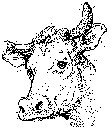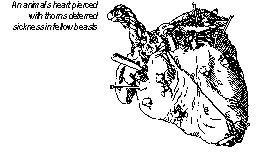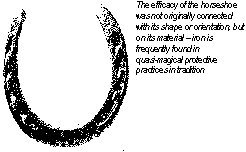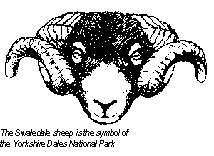‘Old Blighty’ has rarely lived up to its nickname as persistently as it has in the last few years. John Billingsley looks at some old techniques used by farmers to keep their animals sickness-free.
It’s been a grim spring all round for lovers of rural environments, and especially for British farmers. The spectre of disease is a perennial threat to the apparent calm of the countryside, and stock keepers have had to be ever vigilant since the first domestication of animals. Today, there are a range of medicines and knowledge of hygiene standards on the farm that make virulent outbreaks thankfully rare, but as we have seen in recent months the unexpected may occur at any time. The outbreak provided an opportunity, however, to review traditional methods of protection against stock disease – the practices of farmers when vets were scarce and MAFF unborn. How many of these practices are still current today is unknown, but in the light of recent years, perhaps farmers need all the help they can get, from whatever source.
Traditional measures believed that good husbandry was not always enough – if disease got through that, then it must have the assistance of something unnatural (not so different from the way the 2001 problem was spread by modern distribution methods, really). Call it witchcraft, call it what they will – prevention and cure addressed the otherworld as well as this one. Cures were both medical and magical.
Farm animals were protected by a number of talismanic measures. Relatively Christian approaches included this, from Scot’s 1589 Discoverie of Witchcraft: wax from an Easter candle was dripped between the ears and horns of cattle while invoking the Trinity (see below), and a cross of the wax placed over or under the byre threshold so that all the beasts had to pass it. This was best done before church on Sunday [1]. Cattle in Shropshire had biblical texts mixed with their hay fodder (surely better than what many farm animals get today) or Good Friday bread mixed with cider [2]. In 1747, blight so affected the area of Osmotherly in Yorkshire that a chant composed for a church service lamented that ‘No Christian’s bull nor cow, they say, but takes it out of hand; and we shall have no cows at all, I doubt, within this land’ and implored ‘So heaven drive out this plague away, and vex us not no more’ [3]; sentiments that may well have been felt this year in Cumbria. The Rev. Sabine Baring-Gould recorded a charm which was accompanied by making the sign of the cross nine times over the herd of cattle: Our Lord Jesus Christ went over the land, with his staff in his hand, the Holy Ghost in his mouth: in the name of the Father, the Son and the Holy Ghost [4].
More traditional were the four-leaf clover, rowan sprig or holed stone placed in the shed. The naturally holed stone, sometimes called a hag, holey or dobbie stone, was widespread in farmyards. It was thought to offer protection against all kinds of unworldly misfortunes, from the evil eye (which the holed stone might be thought to resemble) to hag-riding (when beasts were found sweaty and tired in the morning, it was attributed to them having been ridden hard by witches or fairies during the night). Limestone was used in the Dales, but flint was especially efficacious; as John Aubrey declared “To hinder the Night Mare they hang on a String a Flint with a hole in it (naturally) by the manger; but best of all, they say, hung about their necks…”. Often attached to the keyring for the animal sheds (where the iron of the keys added an extra element of protection), or suspended just above an affected animal, it can still be seen on some farms, though perhaps with less belief than custom [5].

Other techniques were legion. In Yorkshire, cattle were regularly rowelled to maintain their condition – this involved opening the cow’s flesh, either a pocket in its chest or holes through the dewlaps, and keeping the wound open until it festered. A leather or tarred twine cord was tied through the dewlap holes, sometimes with a holed stone attached; the running wound – which did not seem to cause discomfort, but stank – would draw out ‘the evil humours’ preventing a cow from prospering [6]; elsewhere, a scopperil – a piece of wood with an amulet hung from it – was used, specifically for the ‘quarter-ill’ [6a]. In Yorkshire again, a cure for diarrhoea was to feed the animal a gruel from ground-up clay pipes and the lower jaw of a pig [7]; and soil taken from under a hazel bush was fed to Nidderdale cows that had lost their cud, while the earth underneath a freshly cut turf was reckoned good for scour in Swaledale calves [8].
Elsewhere, a Cheshire farm attributed its immunity from surrounding infection in the 1967 foot-and-mouth outbreak to the onions which the farmwife had placed around the cowsheds [9]. In 1795 Stirling we hear of cow dung forced into a calf’s mouth immediately at birth, as protection against future bewitchment [10] and elsewhere in Scotland red thread wrapped around cows’ tails secured them from the evil eye [11].

An 18th-century cure for cattle from Stowmarket in Suffolk advised a handful each of rue, sage, wormwood and lavender to be infused in a gallon of white wine vinegar in a stone pot and set on a smouldering fire of wormwood for four days. The liquid was then strained and put into tightly corked bottles, into each of which an ounce of samphire was added. A sponge dipped in the mixture was wiped on the noses and mouths of cattle to ward off disease, and would do the same for humans who had been in the presence of contagion [12].
Also to improve immunity, the whitethorn or quickset is a robust bush whose properties could be transferred to young pigs, cattle and horses by leaving their afterbirth on its thorns [13]. Yorkshire calves ears were nicked before they were two Fridays old to prevent ‘speed’, while Northumberland calves could be kept free of the fatal ‘quarter-ill’ by salt sprinkled on their backs and an unbroken egg pushed down their throat [13a] – whether this gave them a disagreeable prescience of the dinner table too was probably not considered.

Sickness in pigs could be counteracted by piercing a dead pig’s heart with pins and white thorns and placing it in the chimney [14].
The method was applied with other animal hearts as well.
Rites were held around the solstice periods for the protection of livestock. Horses and oxen were commonly blood-let on St Stephens Day (December 26) because “it dooth them much good” [15]. Midsummer fires were used as a protective for livestock; if disease struck at any other time, a need-fire (traditionally kindled fire) would be specially made in Scotland and northern England, and cattle driven through the smoke. In the Isle of Man on Midsummer Eve (June 23), herds of cattle were driven through the raked embers of fires as a precaution against murrain; more general protection was afforded by bunches of blazing gorse carried around the beasts [16].

Iron, anathema to the malevolent witch or fairy, was also useful in the fight against their depredations, and iron implements were hung around the sheds – the horseshoe owes its effect to its material, not to its shape, and thus traditionally it did not matter which way up it was hung. This is one of the most popular customs in Britain, and is still very common – though again, whether custom confers the same protective value as belief is another matter. Farriers, whose occupation brings them close to this propitious metal, were often thought to have some knowledge of the magical arts, and an afflicted West Riding farmer was sent to a retired farrier for advice on curing his cattle of foot-rot, or ‘foul’; he was told to go in silence and alone to the orchard at midnight, cut a turf from the foot of the largest apple tree and hang it carefully from its topmost bough. The old man virtually guaranteed that the disease would go as the turf decayed, though some maintained that the turf to be cut had to have been trodden by the sick animal [17]. In Cheshire, the sod would preferably be the shape of the foot., and might be hung on a bush [17a].
Some cattle maladies were attributed in all parts of the country to them being elf-shot, and frequently a pointed flint found nearby would be displayed as proof. The flints were prehistoric arrowheads; one remedy was for the animal to drink water in which the offending stone had been placed [18].
Shrews also had veterinary role; the Shrew Tree in Carnforth, Lancashire, obtained its efficacy from the number of shrews and field mice that had been shut up alive in a hole in the tree, and a twig cut from it and applied to the back of an ailing beast would provide a cure; this custom is also recorded from Sussex and Hampshire, so we may assume the incarceration of tiny mammals was quite widespread [19]. Better for rodents were the Lincolnshire ash-trees under which horseshoes had been buried to imbue the twigs with efficacy [20]. Surrey’s Richmond Park had a shrew-ash to which sickly animals and even children were brought to be cured [21].

Sheep also had their protective measures. In 19th-century Yorkshire, hazel lambs-tail catkins were placed around the hearth to help the ewes at lambing time and rowan collars were put around lambs’ necks; while if a lamb died unexpectedly, its corpse would be hung in a thorn or rowan tree, a custom found elsewhere not restricted to sheep [22]. Lambs’ tails would not be docked during a waning moon, or they would not prosper. In 1957, a Somerset shepherd took a sheep’s heart and stuck it with pins to drive off the problems in his flock [23] (- illus. Hole p.115).
Some places had very specific talismans – in northern Britain were the Black Penny of the Northumberland Turnbulls, the Lockerbie Penny from Dumfries and the Lee Penny, a curious power object from Scotland which consisted of a dark red stone set in a coin of Edward I, the ‘hammer of the Scots’. All were available to farmers in need and bequeathed their power to water in which they were placed. The Lockerbie Penny was particularly effective against ‘madness in cattle’; it was put in a cleft stick and used to stir well water that the beasts would drink. Henderson reports that the penny was loaned out to a Northumberland farmer at a deposit of £ 50 against its return; the cow which had been bitten by a donkey that had been bitten by a rabid dog survived, while the donkey died. When the farmer died, several bottles labelled Lockerby Water were found in his cupboard. The Black Penny was (is?) also a cure for mad cows; it had to be dipped in a spring whose water flowed south to be efficacious [24].
Despite precautionary measures, of course, disease did regularly strike, and in a life or death situation, some farms all over the country turned to practices that were clearly sacrificial in nature. In 2001, great controversy surrounded the MAFF policy of slaughtering healthy animals to stop the disease, but 19th century farmers would more readily have agreed with this measure. They knew that slaughtering a sick beast likely to die anyway would not satisfy the dark power behind the disease – a healthy beast had to die, and be buried ritually at the threshold of byre or field, usually upside down. A Lincolnshire farmer who in 1866 killed a weakening calf and buried it feet up under the byre step failed to stop the disease on his farm – his own cowman blamed him for not offering the best he had [25]. Atkinson recorded five instances of calf burial around Danby on the North York Moors in the late 19th century, as a remedy for premature calving, which tends to strike a whole herd – one had “to remove the threshold of the cow-house in which the mischance had befallen, dig a deep hole in the place so laid bare, deep enough, indeed, to admit of the abortive calf being buried in it, on its back, with its four legs all stretching vertically upwards in the rigidity of death, and then to cover all up as before” [26]. Evans, writing in 1966, recorded that burying a beast in a field gateway, so that the others would pass over it, was “a fairly common practice on Suffolk farms within living memory”. A less drastic preventive measure was available in some districts for premature calving and other ailments which may have had a psychological origin – a billy-goat stabled in the shed with the affected beasts [27].
The slaughter itself could be ritualistic – burning or burying a healthy beast alive was relatively common; a Devon farmer ritually burned a sheep on Catesham Tor in 1853 and succeeded in preventing further deaths among his cattle [28], while at Troutbeck in the 1860s a dairy farmer burned a bull calf alive in his farmyard because an unusual number of males were being born to him. He was following an example at Haltwhistle in the mid-19th century, where an ox received the same treatment to halt an outbreak of murrain [29]. Again in Cumbria, in 1876 a farmer buried a calf alive in front of its mother to stop an outbreak of spontaneous abortion [30].
Farmers wary of killing healthy beasts could try a ritual disposal of a dead calf, for instance by nailing it up above the mother’s stall [31]. In the late years of the century, Baring-Gould found dead horses and calves hung on a tree at Westmeston in Sussex, which he was told was lucky for the remaining animals (I dare say they thought so too) [32]. This was perhaps a rite similar to one in Durham, where a man enquiring about some rope leading up the chimney was told that it held up a leg and thigh of a dead lamb; the farm had lost a number of lambs that year, but none since they suspended the dismembered parts. Wright notes this practice associated with distemper in Lancashire [33]. Similar practices were commonplace in Scotland in the 18th and 19th centuries [34].
Now, we know what these unsettling sacrifices were for, but one has to wonder what they were to. Baring-Gould believed them to be sacrifices to Odin, but it would be wise, I feel, to take a second opinion; and the Lincolnshire cowman who criticised the ritual burial of a sick beast observed that ‘Old Skraat’ would not be propitiated by poor fare. Who, however, was Old Skraat?
Many of these remedies have a clear liminal element in them (such as chimneys and gateways), the idea being that a threshold in this world was also potentially a boundary with the next – hence disease could be sent out of this world, back to where it came from. Pendle farmers hopefully had this in mind, rather than simply getting disease off their patch, when they decapitated cattle who had died of hydrocephalus and left their heads high on the barren moors on the Yorkshire boundary: “Stiperden, a desert plain upon the border of Yorkshire, was the place of skulls”35. One would assume that Yorkshire farmers knew of this custom and either avoided the place, or left their own skulls on the Lancashire side of the border.
However the 2001 foot and mouth outbreak started, its tragedy was the same as stock disease at any time in history – mass slaughter, economic privation and the discord of scapegoating. With the recent animal health problems in Britain – BSE, swine fever and now foot and mouth – the country has seemed to earn its nickname of Old Blighty. If this serves to raise a debate about our treatment of farm animals and the ethics of global capitalism in general, then the sacrifice of so many animals may yet prove worthwhile for them and for us. Given the bad luck of our farmers in recent years, who could blame them if they turned to traditional remedies such as the above for extra protection against who knows what? Let us hope it will be a long while before we see those awful bonfires – literally, bone-fires – in our fields again.
Notes
1 Radford & Hole, 90
2 Baker, 40
3 Baker, 40
4 Henderson, 138
5 Baker, 37-8; Harland & Wilkinson, 154; illus Evans, 181ff
6 Hartley & Ingilby, 98-9
6a Wright, 256
7 Radford & Hole, 90
8 Hartley & Ingilby, 99
9 Baker, 39
10 Opie & Tatem, 103
11 Opie & Tatem, 327
12 Evans, 162
13 Evans, 158-9
13a Wright, 256
14 Hole 1945, 46
15 Thomas Tusser; in Hole 1976, 37
16 Hole 1976, 207; Wright, 256
17 Henderson, 130; Evans, 159-60
17a Wright, 256
18 Henderson 149
19 Harland and Wilkinson, 79-80; Wright, 256
20 Opie & Tatem, 209
21 Hole 1945, 46
22 Opie & Tatem, 65
23 Baker, 47
24 Henderson, 131-2; Baker, 39
25 Radford & Hole, 91; Hole 1945, 46
26 Atkinson, 62, 457
27 Evans, 160
28 Baker, 39
29 Radford & Hole, 91; for other examples, dating back to the 17th century, see Opie & Tatem, 65-6
30 Radford & Hole, 92
31 Hole 1945, 45
32 Hole 1945, 84; Henderson, 134
33 Henderson, 134; Wright, 256
34 Opie & Tatem, 65
35 Harland & Wilkinson, 79; Hole 1945, 46
Bibliography
Atkinson, J C. Forty Years in a Moorland Parish. MacMillan, 1892.
Baker, Margaret. Folklore & Customs of Rural England. David & Charles, 1974.
Evans, George Ewart. The Pattern under the Plough. Faber, 1966.
Harland, John & Wilkinson, T T. Lancashire Folk-Lore. 1892 & EP, 1973.
Hartley, Marie & Ingilby, Joan. Life & Tradition in the Yorkshire Dales. Dalesman, 1981.
Henderson, William. Folk Lore of the Northern Counties of England and the Borders. 1866 & EP, 1973.
Hole, Christina. English Folklore. Batsford, 1945.
Hole, Christina. A Dictionary of British Folk Customs. Granada, 1979.
Opie, Iona & Tatem, Moira (eds). A Dictionary of Superstitions. OUP, 1993.
Radford, E & M A; & Hole, C (ed.). An Encyclopaedia of Superstitions. Hutchinson. 1969.
Wright, Elizabeth Mary. Rustic Speech & Folk-Lore. OUP, 1913
Published in NE86 (Summer 2001), pp.11-16